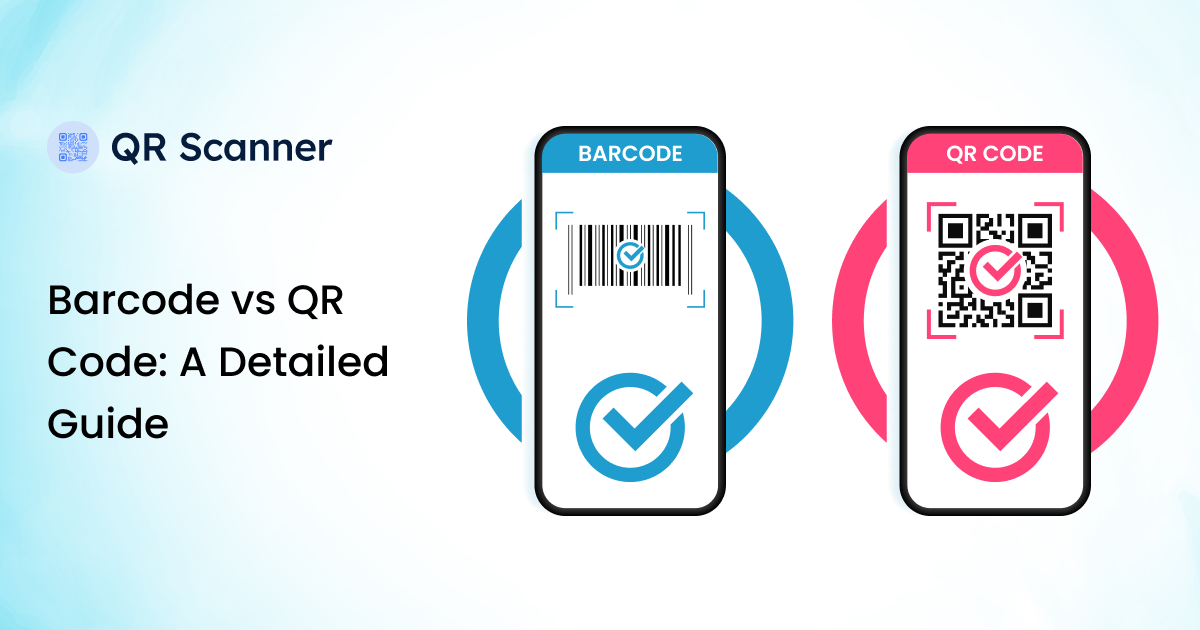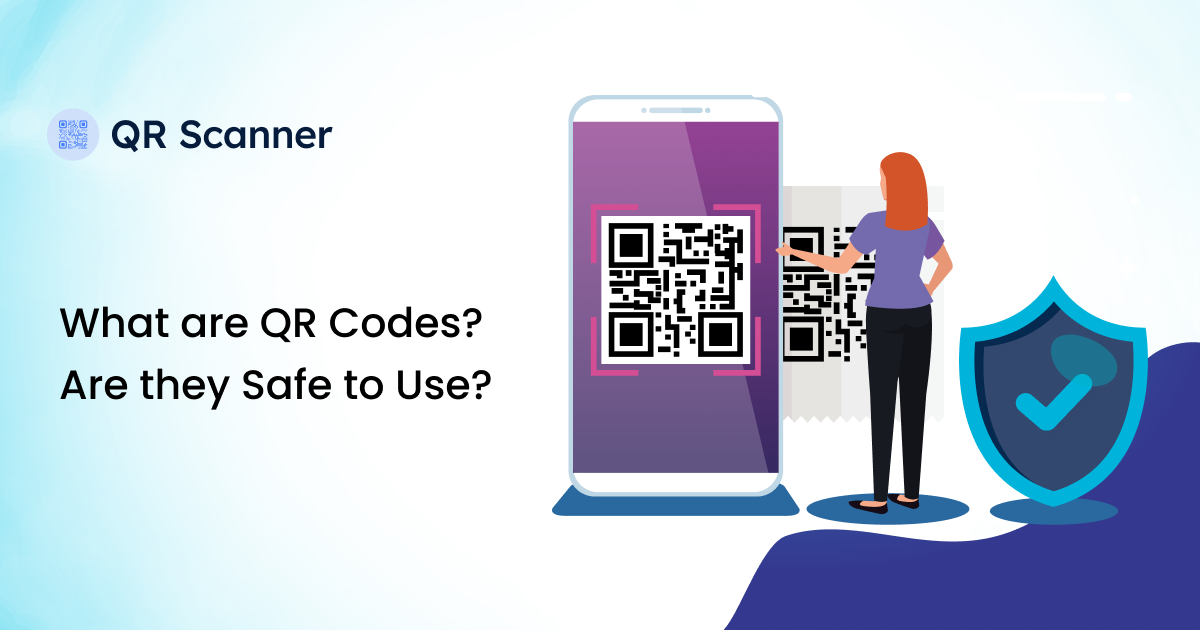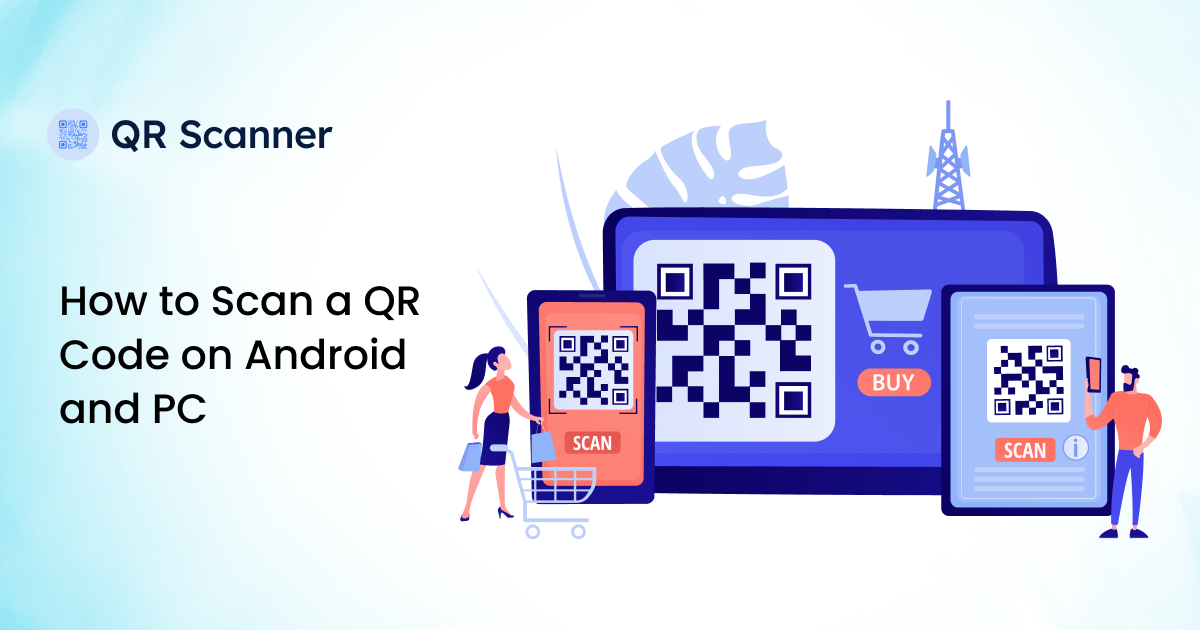Barcode vs QR Code: A Detailed Guide

Barcodes and QR codes are machine-readable modern forms of codes that are meant to store data. We often come across them, such as on product labels, in restaurants, and at cash counters. Barcodes and QR codes are patterns of lines and squares inside boxes.
Many people get confused when trying to differentiate between them. Yet, the purpose of both codes is to store some sort of information. However, they differ in several ways, including their structure, pattern, functionality, and design. This blog post will explain the significant differences between barcodes and QR codes.
A Quick Go Through
Before diving deep into the technical details, below we have provided a quick side-by-side comparison of barcodes and QR codes. Going through this table will help you quickly understand how the two differ.
|
Category |
Barcode |
QR Code |
|
Invented By |
Norman Joseph Woodland & Bernard Silver (1952) |
Masahiro Hara at Denso Wave (1994) |
|
Generation |
First generation of machine-readable codes |
Next generation of barcodes |
|
Structure |
Vertical lines with variable spacing (1D) |
Square matrix of black and white modules (2D) |
|
Data Storage Direction |
Horizontally (single axis) |
Both horizontally and vertically (two axes) |
|
Data Capacity |
Up to 100 characters |
Up to 7,089 numeric or 4,296 alphanumeric characters |
|
Error Correction |
None |
Built-in (Reed–Solomon algorithm) with four levels (L, M, Q, H) |
|
Type of Information Stored |
Product ID, price, stock number |
URLs, text, Wi-Fi credentials, contact info, geolocation, multimedia |
|
Design Appearance |
A series of vertical black lines |
Square pattern with finder and alignment marks |
|
Durability |
Affected by scratches or distortion |
Can be scanned if partially damaged |
Barcodes Vs QR Codes - The Key Difference
To better understand the key differences between QR codes and barcodes, let’s start with the basics. Firstly, for this, you should know what these two codes actually are.
What Is a Barcode?
A barcode is a machine-readable code composed of parallel lines and space patterns. Each combination of line and space inside a barcode represents a readable character, letting them store information inside the code.
Barcodes store information inside these parallel line patterns horizontally. This information typically includes a product name, price, or stock details. Once stored, the data inside can be read/decoded using an optical barcode scanning device or an online barcode scanner.
What Is a QR Code?
A QR, also called a quick response code, is a type of machine-readable code usually composed of square patterns with white spaces. Unlike barcodes, QR codes store information both vertically and horizontally.
No specific external device is needed to read a QR code. The data stored inside can be decoded using an online QR scanner, built-in mobile camera features, or specific apps.
The Timeline from Barcodes to QR Codes
Before diving into the technical differences, let's explore the history behind these codes. This will help you understand where these codes originated.
Barcodes - The First Generation
As per Wikipedia, the story of barcodes began in the 1940s when Norman Joseph Woodland and Bernard Silver started looking for ways to speed up the checkout process. Their efforts became fruitful in 1952, when they successfully patented the barcodes.
However, the real adaptation came in 1973 when the Uniform Grocery Product Code Council officially chose the barcode design suggested by George Laurer in 1970. This is the vertical design of the barcode that we commonly encounter in today's barcodes.
Fast forward to today, and these codes are now heavily used on product tags and packaging.
QR Codes - The Next Generation
QR codes are the next generation of barcodes. They came into being in 1994, when Masahiro Hara, an engineer at Denso Wave, a Japanese company, developed them. The purpose was to label automobile products so that they could be tracked easily.
Visual and Structural Differences
Another element at which barcodes and QR codes differ is their visual appearance and structure. Learning these differences will help you understand how each of these codes stores data.
Structure of Barcodes
Barcodes are made using vertical linear designs. That is why you often hear of them as linear barcodes. They store information in a sequence of vertical black lines having white spaces in between (variable in width).
The information inside barcodes is usually stored horizontally. As the data is stored only on a single axis, these barcodes are also named as one-dimensional (1D) barcodes.
Structure of QR Codes
QR codes consist of a matrix of black and white squares. These squares are usually referred to as modules. Plus, unlike barcodes, QR codes store data both horizontally and vertically. That is why they are also called two-dimensional (2D) barcodes.
Visually, QR codes include special markers such as:
- Finder patterns
- Alignment marks
If you look closely at a QR code, you will find large squares at its corners. These squares are referred to as finder patterns. They help scanners in quickly locating the code’s position and orientation.
While there are some small squares inside the code body, they help keep the code readable even if distorted or placed on a curved surface. These codes are referred to as alignment marks.
Data Holding Capacity
Another difference between barcodes and QR codes lies in their data holding capacity and error correction capabilities.
As we mentioned earlier, barcodes store information on a single axis. That is why their data holding capacity is relatively low. Typically, barcodes can hold data of less than 100 characters. However, this can still vary depending on the type of barcode.
As an example:
- Barcode type 128 can hold 45 to 80 characters.
- Barcode type 39 can hold 20 to 23 characters.
QR codes store information on both axes, horizontal and vertical. This is why they have more data holding capacity than 1D barcodes. QR codes can usually hold:
- Numeric data: Up to about 7,089 characters
- Alphanumeric data: Around 4,296 characters
- Binary data: Roughly 2,953 bytes
Error Correction Abilities
Another key difference between barcodes and QR codes lies in their error detection capabilities. In fact, barcodes by default do not have any error detection capability.
Unlike barcodes, QR codes have a built-in error detection system. This system is actually based on the Reed–Solomon algorithm, which can detect and correct multiple symbol errors. This mathematical method adds redundancy to the stored data. It can reconstruct the original information in case a part of the code is:
- Missing
- Covered
- Damaged
QR codes offer four levels of error correction. Each of these levels is designed for different reliability needs:
- Level L (Low). It can recover up to 7% of data.
- Level M (Medium). It recovers up to 15% of data.
- Level Q (Quartile). This level can recover up to 25% of data.
- Level H (High). It has high error correction ability and can recover up to 30% of data.
This redundancy ensures scanning reliability, even under poor conditions. In contrast, even a slight distortion of linear barcodes can make them fail to scan completely.
Functional Differences of Barcodes and QR Codes
Both barcodes and QR codes are meant to encode data that machines can read upon scanning. However, both of them are designed particularly to perform different functionalities. This is another element that differentiates the two codes. Here’s how.
Barcodes - Simplicity & Speed
As we mentioned earlier, barcodes are meant to speed up the checkout process. So, if we say they are built for the goal of enhancing efficiency, it would not be wrong.
Barcodes are well-suited for work environments where items are constantly scanned in large volumes. For example, at supermarkets, pharmacies, warehouses, and other similar locations.
As we discussed earlier, barcodes can encode only a small amount of data. If you scan them, it would just take milliseconds. This thing makes barcodes ideal for high-throughput operations.
QR Codes - Versatility & Connectivity
QR codes are known for bridging the gap between the offline and online worlds. These two-dimensional barcodes take the concept of machine readability a step further. Many people mistakenly believe QR codes are limited to product tracking only. But in reality, that is only one of their functionalities.
Unlike barcodes, QR codes can hold more and different types of information. For example, inside QR codes, you can embed:
- URLs
- Images
- Videos
- Text
- Wifi credentials
- Payment information
- Email address
- Geolocation data
- Authentication tokens, etc.
These are the elements that make QR codes a powerful tool for digital marketers. They use them to turn any printed or physical surface into an interactive gateway.
In payments and authentication, QR codes have become the backbone of modern cashless transactions. From restaurant bills to ride-sharing apps, users can scan a code to complete payments securely and instantly.
And since nearly every smartphone comes with a built-in camera, it's a standard feature. You can scan QR codes with the help of these cameras while using an online QR code scanner.
Conclusion
Barcodes and QR codes are both designed to store and share information quickly. Still, both are different in several key areas. For example, barcodes are usually used for quick checkouts or inventory tracking. QR codes are primarily used to enhance digital interaction. They enable businesses to link offline materials with online resources.
Related Blogs

What are QR Codes? Are they Safe to Use?
Explore what QR codes are, how they work, and whether they are safe to use.

How to Create a Free WIFI QR Code - 5 Easy Steps
Learn how to create a free WIFI QR code in 5 easy steps

How to Scan a QR Code on Android and PC
Learn our comprehensive guide on How to Scan a QR Code on Android and PC